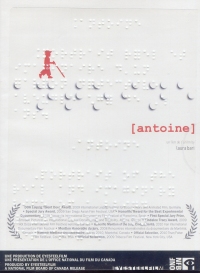| ________________
CM . . . . Volume XVIII Number 22 . . . . February 10, 2012
excerpt:
This film portrays the real and imaginary lives of Antoine, a boy detective who happens to be blind. Antoine, a child of Vietnamese origin, was born prematurely but, by the age of five, he is fully integrated into the regular school system of Montreal. He participated in co-creating the soundtrack of the film by recording and describing the sounds around him over the course of two years. The film was written, directed, and produced by Laura Bari, and her intent was clearly to provide insight and awareness about how a child who is blind experiences the world. By going beyond his daily interactions with adults at home and at school, and opening the audience up to the world of his imagination and play with other children, Bari exceeds this goal. Not only does she show viewers the variety of ways that tasks requiring vision can be adapted for a blind child, she also shows how similar and connected all children are in terms of expressing their emotions and engaging in imaginary play. The focus of the film is not Antoine's difference, or more specifically his blindness, but rather his pretend role as a detective. He is trying to solve the case of Mrs. Rouski who has dissolved into water while showering and has asked him for help. The framework of this imaginary game shifts the film away from a typical documentary format and allows viewers to learn about Antoine through a playful story instead. Viewers get to see how, in his imagination, a five-year-old blind child can drive a car at night or travel back to his country of origin. Viewers also see how these ideas are easily embraced by his friends, Maella and Julietta, who help Antoine look for clues and add ideas of their own to try to solve the case. The purpose is not to exaggerate Antoine's talents or abilities, but simply to show him for who he is, including the challenges, sorrows and joys he experiences. In this way, viewers see how ordinary Antoine is, as well as his extraordinary nature. It is important to point out that the film is accompanied by a Lesson Plan developed by Louise Sarrasin, an educator in Montreal. These activities are targeted to students aged 12 to 17 years with the purpose of raising their "sensitivity about what it means to live with a handicap so as to encourage them to develop an open mind and see beyond another person's disability or difference." The lesson is divided into two main activities. The first one is titled "Using our senses to live a full life" and involves the students' completing a worksheet about how they used their five senses prior to viewing the first half of the film. The second activity is titled, "Seeing with your heart," and requires that the students record specific observations as they view the remainder of the film. For both activities, a list of discussion questions, as well as a variety of additional supporting sources, are provided. An appendix is also included that breaks the film down into smaller sections (3 – 4 minute segments) with accompanying descriptions and discussion topics for each segment. In this way, it is possible for teachers to select segments, as appropriate, if viewing the entire film is not possible. The film, itself, is in French but has several viewing options, including English subtitles, as well as both French and English Described Video. The camera view is often a close-up of Antoine, and this approach helps to convey the sense of "being in his head". The cinematography also contrasts darkness and light effectively to create a feeling of not seeing or understanding clearly. The scenes throughout the film appear very natural, and the cinematographer's presence does not seem to interfere with or impact the behaviour of the adults or children involved. Antoine, in particular, is very comfortable with the microphone and does not come across as "performing". His use of the microphone fits with his role of detective, and this is his tool for making observations and recording his thoughts. The film truly provides an incredible insight into a child's mind. Overall, the film is entertaining and informative and provides a much needed first-person perspective of a young child with a wonderful imagination who happens to be blind. Highly Recommended. Charlotte Enns teaches in the Faculty of Education at the University of Manitoba and conducts research related to literacy development of Deaf children.
To comment
on this title or this review, send mail to cm@umanitoba.ca.
Copyright © the Manitoba Library Association. Reproduction for personal
use is permitted only if this copyright notice is maintained. Any
other reproduction is prohibited without permission.
NEXT REVIEW |
TABLE OF CONTENTS FOR THIS ISSUE
- February 10, 2012.
AUTHORS |
TITLES |
MEDIA REVIEWS |
PROFILES |
BACK ISSUES |
SEARCH |
CMARCHIVE |
HOME |
